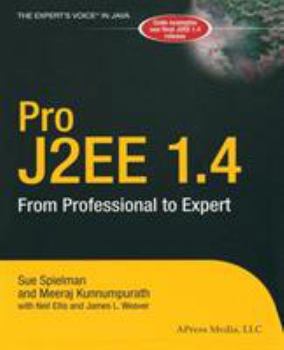Pro J2EE 1.4: from professional to expert
This new edition is a complete rewrite of the book and will be a completely cohesive book that covers the new version of J2EE: 1.4.
Format:Paperback
Language:English
ISBN:1590593405
ISBN13:9781590593400
Release Date:June 2004
Publisher:Apress
Length:908 Pages
Weight:3.18 lbs.
Dimensions:1.9" x 7.0" x 9.1"
Customer Reviews
2 ratings
a massive overlayer
Published by Thriftbooks.com User , 19 years ago
Regular Java is at version 1.4 going onto 1.5. But from the earliest versions, many optional classes were added to the core Java to form J2EE. Now this book gives you a lengthy description of the bulk of J2EE 1.4. You can see that J2EE revolves around the Web, not the Internet. For the latter, the low level network communications classes in the core Java suffice. But at the level of the Web, we have web servers, often making dynamic web pages using JSPs and Servlets. The importance of these is shown in how the authors devote 5 chapters to these two intertwined ideas. One cannot be adequately explained without describing the other. But the authors show that for practical, commercial websites, that is not enough. Often, the Web servers must hook up to a backend database, using EJBs - entity, session and message beans that act as an intermediate layer. Another 4 chapters here. And you get explanations of how to handle XML documents, which are now the standard for data interchange. Leading right into Web Services, which may be the Next Big Thing. Perhaps. Each of these topics is often discussed in more detail in other books specifically devoted to each. But under one cover, you can get a good understanding here.
Surprising front-end centric balance
Published by Thriftbooks.com User , 20 years ago
I was surprised by how much material there is on the front-end of the J2EE equation. About half the book is spent on the front end with excellent chapters on JSP 2.0, JSTL, Servlets and front-end security. Attention is also paid to the back end. Chapter 11, which weighs in at 50 pages out of 900, is on EJBs and the various O/R mapping and persistence objects. The back end coverage then continues on with chapters on messaging, XML processing, and web services. This is not an all-in-one book. The coverage, with perhaps the exception of the front end, is not thorough enough to replace a full book on any one of these topics. In particular the chapter on persistence is far too brief for any thorough explanation of the topic. That being said this does act as a solid field guide to provide an end-to-end view of the landscape of J2EE development.






